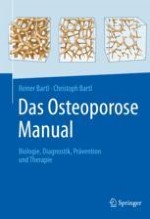2021 | OriginalPaper | Buchkapitel
27. Behandlung osteoporotischer Frakturen
verfasst von : Reiner Bartl, Christoph Bartl
Erschienen in: Das Osteoporose Manual
Verlag: Springer Berlin Heidelberg
Zusammenfassung
-
Bei älteren Patienten sind über 80 % der operationspflichtigen Frakturen mit einer erniedrigten Knochendichte verbunden.
-
Bei geriatrischen Patienten müssen Komorbiditäten mit im perioperativen Management und in der Nachsorge berücksichtigt werden.
-
Frakturen des distalen Radius sind beim älteren Patienten in hohem Maße mit einer Osteoporose vergesellschaftet, wobei Frauen ab dem 60. Lebensjahr etwa 6-mal so häufig betroffen sind als Männer.
-
Proximale Femurfrakturen generieren den Großteil der Kosten aller osteoporotischen Frakturen, da sie immer mit einer Hospitalisierung, einer operativen Versorgung und einer aufwendigen Rehabilitationsphase verbunden sind.
-
Bei den Wirbelkörperfrakturen (WKF) handelt es sich meist um schleichende Sinterungsfrakturen, die symptomarm ablaufen und deshalb häufig nicht diagnostiziert und therapiert werden. Circa 50 % der WKF werden klinisch symptomatisch, sie können auch unerträgliche Schmerzen („Vernichtungschmerz“) auslösen.
-
In Metaanalysen konnte bei frischeren Frakturen ein Vorteil der Vertebroplastie/Kyphoplastie gegenüber einer alleinigen Schmerztherapie nachgewiesen werden. Mögliche Komplikationen sind eine Zementextrusion, Mikroembolien/Lungenembolien und vertebrale Anschlussfrakturen.
-
An die Frakturversorgung schließt sich die Rehabilitationsphase mit einer schrittweisen Mobilisierung, Maßnahmen zur Sturzprophylaxe und der Einleitung einer leitliniengerechten Therapie der Osteoporose an, um die Knochenstabilität zu verbessern und Folgefrakturen zu vermeiden.















